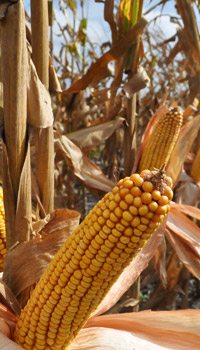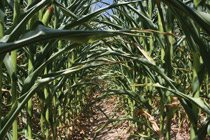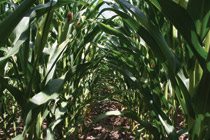As corn growers exit one of the worst drought years in decades and turn to planning for 2013, the first inclination for seed retailers might be to sell, sell, sell drought tolerant corn products. Not so fast. There are many factors to consider before selling next year’s products on last year’s circumstances. The name of the game for 2013: manage production risk by planning a diverse portfolio of products with growers.
As of the start of November, the USDA Drought Monitor was reporting that 50 percent of the continental United States is still mired in “moderate drought” conditions, while 32 percent are in “severe drought,” 20 percent are in “extreme drought” and five percent are in “exceptional drought.” These numbers look slightly better than they did in the middle of August, but there is no question that 2012 has been one of the worst drought years in history.
“The summer of 2012 was the most difficult growing season across the Corn Belt since at least 1988; some would argue perhaps the most difficult ever,” says Ron Wulfkuhle, head of GreenLeaf for Syngenta.
However, despite 2012’s less than ideal conditions, retailers are already in high gear selling product for next year’s planting season. And while selling drought tolerant corn may seem like a no-brainer, industry experts are warning that there are many factors to consider if you don’t want to be faced with unhappy growers in 2013.
Long-Term Planning
Many producers use the past season as a guide for planning for the next one, but that isn’t the best policy for growers who want to get the most from each acre. Instead, it’s best to help growers plan for next year by telling them to look at the long-term weather trends.
“This past growing season was obviously extremely dry for most growers across the Corn Belt, as many of them have suffered from the drought,” says Josh St. Peters, DuPont Pioneer corn marketing manager. “That may be the central focus for many growers as they select corn hybrids for the next growing season. But weather changes from year to year and we can’t predict the next growing season. Rather than using this past year’s drought as a guide, growers should look at several seasons and rely on that information to make decisions.
“Growers should look at the more long-term trends in their region and in their specific fields. No year is the same as the last so plan for a typical season,” he adds.
Mark Edge, Monsanto’s DroughtGard Hybrids marketing lead, agrees and recommends sitting down with growers to help them better understand long-term planning. “2012 was obviously a challenging year out in the field. Since it was not a typical year, dealers and farmers should sit down and review the history and environment of the field over a number of years when making purchase decisions,” he says.
Product Positioning
According to Wulfkuhle, there are two main reasons retailers need to carefully position products for 2013. Number one: Due to the extreme drought there are big differences in the genetic combinations that are at the top of trials in 2012 compared to 2011. “Not a surprise to anyone familiar with genetics that those hybrids that take stress better are outshining some of the bin busters of 2011,” says Wulfkuhle. “If it is assumed that 2013 is more ‘average’ than 2012, then a retailer should be positioning products on multi-year performance and based on information provided by the seed company or genetics supplier.”
Number two: Based on a retailer’s experience in 2012, Wulfkuhle says it might be enticing to tell a grower that when he plants a hybrid containing, for example, Syngenta’s Agrisure Artesian, he gets 20 bushels more yield as demonstrated in many trials. “This seems an easy sell and probably is, but it is not the right way to sell,” says Wulfkuhle. “If 2013 is a very high-yielding year with little drought stress, the grower is going to be calling the retailer complaining that he didn’t get the 20 bushel increase he ‘heard the retailer promise’ and may switch retailers.”
Wulfkuhle says a better positioning is to have a discussion that sets a better expectation, where the grower understands that if the season has inadequate moisture conditions, he will see a yield benefit. However, if it is a year with little to no drought stress, then the yield increase may be small or non-existent, but the hybrid will perform comparatively to other high-yielding hybrids.
Managing Risk
St. Peters encourages growers to work with their seed sales professional to choose the right product for the right acre. “Ask yourself ‘What are the characteristics of the field and what traits are needed to get the greatest return for each acre?’ Evaluate the agronomic traits needed for each field and select appropriate hybrids,” he says. “Know the insect pressures of each field and choose hybrids with the right insect protection traits. Select hybrids that match the tillage operation, whether it’s conventional, minimum till or no-till. Know each grower’s field and choose the product that best fits the complex needs of each.”
“Growers should look at the more long-term trends in their region and in their specific fields. No year is the same as the last so plan for a typical season”
— Josh St. Peters
What it comes right down to is helping farmers manage their risk, and that doesn’t revolve around just water or weather conditions. “In addition to drought, dealers should work with farmers to consider all the agronomic factors impacting the farm, including insect and disease pressure, as well as tillage and weed control practices. All of these factors should be considered when selecting the best hybrid for a field to maximize yield,” says Edge.
Wulfkuhle takes it a step further and says the key to managing production risk is by planting a portfolio of differing base genetics. “I would recommend a retailer understand his growers’ farms and make hybrid recommendations that best position the right genetics on those farms,” Wulfkuhle says.
“The retailer should know his product portfolio well enough to sell a ‘package’ to the grower. I sometimes hear ‘I want to package a portfolio to the grower to blend high-priced products with some low-priced ones to get the order with a lower average selling price.’ When ‘packaging’ or putting together a portfolio, the first driver should be for the retailer to optimize the growers production goals—for some it might simply be yield, for others it might be managing risk or for others it might be input costs—but this should always be done with a combination of genetic offers.”
Beating Drought with Biotechnology
Monsanto’s DroughtGard Hybrids are one of several drought tolerant products on the market today—and the first biotech solution. Edge says that Monsanto’s Genuity DroughtGard Hybrids system, which combines germplasm selected for its drought tolerant characteristics, the drought tolerant biotechnology trait and agronomic recommendations, has “demonstrated strong performance in Monsanto’s Ground Breakers on-farm testing program this season.”
The system is designed to help the corn plant so it can use less water when drought stress occurs, explains Edge. “This improved hydro efficiency creates the opportunity to conserve soil moisture and can help minimize yield loss from drought conditions.”
This season, approximately 250 farmers participated in Monsanto’s Ground Breakers large-scale, on-farm testing program by planting DroughtGard Hybrids on their farms to get first-hand experience with the new product. “The farmer’s experience with our DroughtGard Hybrids is the most important aspect of the Ground Breakers trials,” says Edge. “Co
mpared head-to-head with competitor hybrids marketed to the drought segment, the DroughtGard Hybrids we’ll commercialize from Ground Breakers showed a yield advantage of approximately five bushels an acre.”
For the 2013 season, Monsanto will have a stewarded commercial introduction of DroughtGard Hybrids in the western Great Plains. Farmers who purchase DroughtGard Hybrids must sign a stewardship agreement committing to use the grain as on-farm feed or to sell the grain for domestic use due to pending import approvals in key export markets. While Monsanto anticipates all key regulatory approvals to be completed during 2013, the company will be working with farmers and the grain trade to assist in identifying domestic markets until all such approvals are received.

DroughtGard Hybrid in a Texas field in 2012. Photo courtesy of Monsanto. |
Best of Both Worlds
DuPont Pioneer also offers a drought tolerant corn product, and St. Peters says the advantage of Pioneer brand Optimum AQUAmax hybrids is that they take the guesswork out of creating the right balance. “They have been shown to out-yield competitive hybrids in water-limited environments and also offer top-end potential in optimal growing conditions,” he says. “Also, these results have been shown in on-farm trials across at least two growing seasons—in 2011 and 2012.”
On more than 11,200 side-by-side comparisons with competitive products, says St. Peters, final 2012 yield data from DuPont Pioneer shows an advantage of more than 8.9 percent with Optimum AQUAmax products in water-limited environments and almost a two percent yield advantage in favorable growing environments.
“Across the past two growing seasons, among more than 19,200 comparisons, Optimum AQUAmax hybrids have shown a 8.7 percent yield advantage in water-limited environments and a 2.6 percent yield advantage in favorable growing conditions,” St. Peters says. “I would caution against making purchase decisions based on limited field trials. Choose products that have been tested under a number of different regions and under a variety of different growing conditions.” Pioneer launched the Optimum AQUAmax hybrid in 2011.
Tapping Into a Native Trait
Syngenta was the first company to bring to market a water optimization solution with the launch of its Agrisure Artesian, a native trait offer with the potential for subsequent biotech combinations. According to the company, the product offers 15 percent yield preservation in mid- to high-drought conditions without yield drag. Growers in the western Corn Belt were first able to purchase Syngenta’s Agrisure Artesian hybrids in 2011.
Agrisure Artesian technology enables corn plants to use available moisture more efficiently, resulting in higher yields on drought-stressed acres including dryland and limited-irrigation farms in the western Corn Belt. Growers on rain-fed acres in the central and eastern Corn Belt likewise can use Agrisure Artesian technology to help stabilize yields in years of inconsistent rainfall or in fields with variable soil types and moisture-holding capacity. And, according to the company, in years of ideal rainfall, hybrids with Agrisure Artesian technology have demonstrated no yield penalty compared with hybrids without the technology.
Wulfkuhle says Syngenta will continue to expand its portfolio of hybrids in 2013, with elite hybrids containing Agrisure Artesian technology available for most areas of the Corn Belt. “While Syngenta has strong launch-year supply, demand for hybrids with Agrisure Artesian has been high,” says Wulfkuhle.

Non-Agrisure Artesian hybrid in an Illinois field. Photo courtesy of Syngenta. |

Hybrid with Agrisure Artesian technology in an Illinois field. Photo courtesy of Syngenta. |
“For 2013 and beyond, Syngenta will move quickly to incorporate our industry-leading insect traits, including Agrisure Viptera, into hybrids with Agrisure Artesian technology, and to expand our portfolio to all areas of the Corn Belt.”
Syngenta is also developing a complementary water-optimized hybrid product utilizing a genetically modified trait. These hybrids are anticipated to be available post-2015, pending receipt of all regulatory and key import market approvals.
While all of these products offer excellent solutions to increase water use efficiency, they are still not water resistant. Therefore retailers need to help growers understand that the best strategy when purchasing seed following a drought is to look at the long-term regional weather pattern and make product selections based on that and the needs of each field. “We have no crystal ball to predict the weather for next year,” says St. Peters, “but we do know what’s occurred in the past, using that as the basis for probable future growing conditions.”
Julie McNabb
|
The Basic Factors First of all, the impact of the drought is still uncertain. Looking back, the drought of 1988 brought with it a reported cost of $77.6 billion, while 2005’s Hurricane Katrina, the most expensive natural disaster in U.S. history, cost $146 billion. “We anticipate this drought will bring with it a larger cost than the 1988 drought, but quite a bit less than Katrina,” said Purdue extension agricultural economist Corinne Alexander in a recent webinar, Agricultural Outlook 2013. In addition, drought conditions have been improving slightly this fall throughout the Corn Belt. “This improvement trend is great news,” said Alexander. “We are in a situation where we have very low sub-soil moisture levels and so we need to see more rains to recharge our sub-soil moistures. We need that moisture for the next crop, but what really matters is what happens next summer.” That leads to the biggest factor, which lies with Mother Nature—and while it is impossible to accurately predict weather patterns from year to year, Alexander presented the following conclusions, drawn from analysis of historical weather trends, to give a general idea of what to expect going into 2013: • There is little persistence toward year-after-year droughts in the eastern Corn Belt. • The odds of a drought in 2013 in ECB are about the same as in any year. Each growing season is independent of the next. • The Great Plains has a stronger persistence toward year-after-year drought than the Corn Belt does. • The difference for the ECB is the flow of moisture out of the Gulf of Mexico. • 2012 sheds little light on whether global warming was a contributor, or was NOT a contributor—the United States had droughts of this magnitude in 1934, 1936 and 1988. |










